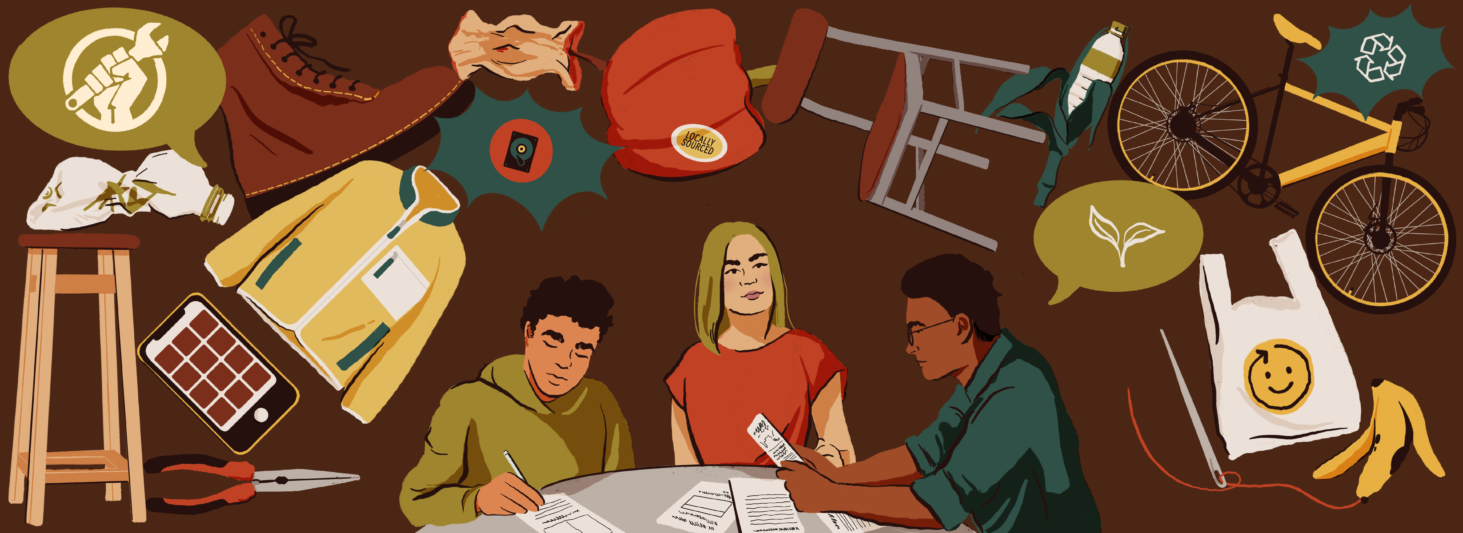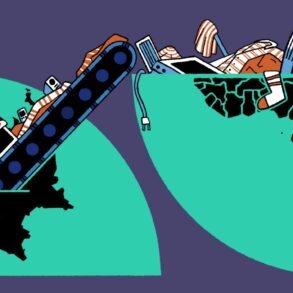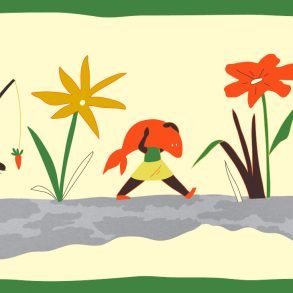What is circularity and where did it emerge from?
Circularity is a term used to describe processes or systems that embed resources in cycles rather than letting them go to waste.
In a circular economy, for example, products and materials are kept in use through practices like repair, reuse, remanufacture, restoration, recycling, and composting. This stands in contrast to the linear way that most economies work today, where raw materials are collected, transformed into products which are used briefly, and then thrown away.
The concept of a circular economy first became popular in the late 20th century, but has its roots in earlier schools of thought like industrial ecology, biomimicry and the Cradle to Cradle approach to design. But, in its broadest sense, circularity is founded on much older ways of knowing, making and living: ones inspired by the natural world and which balance the needs of people with the needs of the planet. In this, there is a lot that we can learn from our own pasts and from Indigenous communities, who have embodied these practices for millenia.
How is circularity a climate justice issue?
In a linear economy, waste is the end point; the full stop. Because of this, all kinds of waste are now threatening our ecosystems: plastic waste, textile waste, food waste, electronic waste, and construction waste – just to name a few.
The numbers are staggering: our landfills are growing by some 2 billion tonnes of rubbish every year. If all this waste was put on trucks, they would stretch around the Earth 24 times. Meanwhile, less than 1% of all the clothing we consume is recycled, and over one-third of all the food we produce ends up lost or wasted.
Before it even reaches the consumer, this economic chain generates enormous amounts of carbon, methane and nitrous oxide. In fact, the production of everyday goods and services currently accounts for a full 45% of global greenhouse gas emissions. Water and land are also exploited throughout this process, leading to alarming rates of habitat and biodiversity loss.
In total, according to the Global Footprint Network, we are already consuming 75% more resources than the Earth can sustain in the long term.
Changing this – and building a new economy that gives back as much as it takes – is one of the greatest challenges facing our generation. Circularity can give us the tools to do so, starting with its three key principles: eliminating waste, keeping products and materials in use, and regenerating natural systems. In fact, research suggests that applying circular strategies to just five of the most common material industries (cement, aluminium, steel, plastics, and food) can eliminate 9.3 billion tonnes of CO2 by 2050.
It would also allow countries to grow prosperity, jobs, and resilience while reducing the natural resources humans use by 30%. If we understand the specific challenges facing communities around the world, circular strategies can even help them adapt to local climate urgencies, from building more resilient homes to restoring polluted oceans and waterways.
How does circularity address issues of waste colonialism? And what industries could most benefit from circularity?
Though waste poses a global challenge, its burden is not shared equally around the world.
The first reason is that consumption patterns differ greatly from region to region. Because most economies are linear, the formula is simple: the more you buy, the more you end up throwing away. According to the World Bank, even though they only account for 16% of the world’s population, high-income countries such as those in Europe and North America currently produce more than one-third of the world’s waste. In this, consumer goods industries like food, packaging, fashion and electronics are some of the biggest culprits.
Another key issue lies in the exploitative global waste trade. As things stand today, most countries are unable to manage or process their own waste efficiently. Many wealthy nations regularly export their plastic, textile and electronic waste to low income and Global South countries such as Ghana, Turkey and Indonesia.
For those taking in the rubbish, it represents a valuable source of income. However, because the entire system is poorly regulated and inefficient, a lot of toxic waste ends up leaking into the environment, significantly impacting the health and wellbeing of local communities.
Furthermore, it is estimated that up to 30% of waste shipments might be illegal, making it difficult to gather accurate data and implement solutions beyond waste recovery and recycling.
In many countries, the management of waste also relies on informal workers and pickers, who are typically undervalued and left out of policy frameworks despite playing an important role in the system. This puts pressure on an already vulnerable population often made up of women, children, the elderly, the unemployed, and migrants.
Making the shift towards a circular economy means addressing these aspects of waste colonialism head-on and changing how things are managed upstream as well as downstream. It demands a transition that is transparent and inclusive, and that considers the socio-political as well as ecological dimensions of our products, businesses and supply chains.
How does circularity link to processes of decolonisation more widely?
For too long, the discourse around sustainability and circularity has been dominated by paternalistic perspectives from rich countries, and is thus tied to a long history of colonisation. But sustainability – as a daily practice, as a way of relating to nature – is neither new, nor modern, nor urban. Indigenous knowledge proves this and provides approaches to resilience that are based on a holistic view of the world and a cyclical understanding of all things in it.
One widely-read example of this knowledge is the Honourable Harvest as described in Robin Wall Kimmerer’s 2013 book Braiding Sweetgrass. The basis of the Honourable Harvest hinges on our relationship with ‘natural resources’. To call a nonhuman thing in nature a ‘resource’ is already to treat it as an object that can be used up as we wish. But if we consider these nonhuman ‘resources’ gifts, or as beings in and of themselves, then overusing a ‘resource’ would amount to stealing a gift or abusing a living being. Adopting the Honourable Harvest then necessitates an ethos of reciprocity, a balance of giving and taking between humans and the other beings that sustain them.
Granted, plenty of people in power steal resources and harm people regardless of the morals of doing so. But it’s traditions like this (and knowledge that these traditions are aeons old, older than anyone currently alive) that will help us tackle our internalised colonial relationships with nature and provide us with alternatives to concepts like growth, progress, efficiency, and capitalism, as well as the means to push back against them.
How does circularity link to ideas of re-imagination?
We’ve seen firsthand the vital role that creativity can play in the circular transition. Not only in terms of delivering new materials or designs, but also in terms of providing alternative visions of the future. Because building a better world is a process that starts with radical imagination: facing the unknown, redefining what’s possible, and inspiring others to do the same. This can be done through practices like storytelling and world-building, or through creative experiments that make concepts like circularity, regeneration or the green economy more tangible and desirable.
There is also an urgent need for more tools of resistance: ways to reveal and redesign the invisible structures that govern our lives, from how we exchange goods and services, to who owns a city’s energy. Here, creative activists can collaborate with scientists, policymakers and industry leaders to make new ideas compelling and social movements irresistible.
This kind of vision is essential to circularity because it has the power to shape culture, and to help people redirect their anger and anxiety into collective action.
How can we incorporate circularity into our everyday life?
While circularity is often equated with recycling, there are many other useful strategies worth incorporating into our daily lives. The R-ladder is a handy diagram that can be used to rank and prioritise these strategies according to their potential impact. Generally, strategies higher up on the ladder focus on consuming fewer resources, and therefore have more impact in the long-run. At the bottom of the ladder are strategies for recovering used or wasted materials, which are helpful, but will not be enough to create the systemic change that is needed. Here, we break them down into three main categories of action.
- Consume fewer resources
- Refuse single-use: Challenge throwaway culture by saying no to single-use plastics and items. Invest in reusable alternatives, such as water bottles, bags, and containers, to reduce the demand for disposable products.
- Borrow instead of buy: Before making a new purchase, consider borrowing items that you might only need temporarily. Collaborate with neighbours or utilise community sharing platforms to minimise the need for ownership.
- Repair instead of replace: Instead of replacing your items at the first sign of wear and tear, explore the possibility of repairing them. This not only extends the life of your belongings but also reduces the demand for new resources.
- Eat less meat: Consider reducing your meat intake and replacing it with less resource-intensive proteins.
- Make (and choose) better products
-
- Materials matter: Not all materials are created equal. Whether you’re designing, selling or buying a product, be mindful of the kinds of plastics, textiles or metals that it contains. If possible, opt for alternatives that are recycled, recyclable or biodegradable, and that require less water, land and energy to produce.
- Opt for longevity and quality: Choose higher-quality items that are designed to be repairable and/or durable. This is especially important when it comes to electronics and fashion.
- Keep it local: Remember that locally-sourced products are more likely to have circular supply chains than their alternatives. This goes for food but also for things like travel. Rather than taking planes and cars, consider travelling closer to home or alternative mobility options like ride-sharing services or trains.
- Advocate and educate others: Exercise your political power. Engage with local organisations to advocate for regulations that support a circular economy, like the right-to-repair, the greenwashing directive, or the extended producer responsibility for textiles.
- Handle waste responsibly
-
- Recycle when appropriate: Take the time to understand and follow your local recycling guidelines. Properly segregate recyclables whenever possible, while also educating yourself on the costs and criticisms of recycling.
- Upcycle old items: Learn crafting and upcycling techniques to transform old items into new creations. Join community programmes and clubs to promote a culture of sharing and resilience.
- Start composting: Transform kitchen and garden waste into nutrient-rich compost. Composting is a simple yet effective way to reduce organic waste and contribute to healthier soil.
- Join clean-up initiatives: Get to know the people in your community who are dealing with waste on a daily basis. Support local clean-up events and other grassroots initiatives that raise awareness around those who are most impacted by waste.
What does circularity look like at the community level?
Many of the most successful circular projects around the world are built around communities of practice. They are often focused on giving people access to tools and resources, bridging the gap between consumers and producers, and designing opportunities for healing and learning.
Examples include social enterprises like Repair Café, Agbogbloshie Makerspace Platform and Project R and Precious Plastic, which are all about upskilling and reskilling communities in making and mending. There are also plenty of neighbourhood-level programmes focused on composting, gardening and growing food together, or sharing and swapping household goods and appliances. For businesses and business owners, circularity at a community level can also look like building better relationships across different parts of your supply chain, from the people who make your products to the recyclers who will eventually process them.
Who are some key leaders in the movements?
Though circularity is one of the most powerful concepts we have when it comes to building a more sustainable economy, we’d like to stress that it is not a panacea. In reality, it is a dynamic and complex system that must be bolstered by progress in other sectors like conservation, human rights and renewable energy.
What circularity does provide are valuable new goalposts – and a useful set of principles that can be applied to everything that is designed. By embedding circular strategies into our production processes, we can prevent waste from the start and reduce the overall impact of major industries like fashion, food, construction and mobility. The idea here is that over time, each value chain that is made circular will inspire new ones to emerge, until everything is that way.
This integrated and iterative approach is exciting because it is inherently collaborative and process-oriented. It allows us to work towards a generative goal – one that is less concerned about reaching ‘net zero’ and more interested in changing the way societies measure, manage and distribute value. None of this will be easy, but the transformation is already underway. There are plenty of creative thinkers who have taken an active role in the movement, from economists like Kate Raworth who developed the concept of doughnut economics, to environmentalists like Ellen MacArthur who set up one of the world’s foremost foundations working on circular economy and design.
Other key figures that are expanding the discourse include educators like Leyla Acaroglu of Disrupt Design, Céline Semaan of the Slow Factory Foundation, and Sophie Thomas of Useful Projects, alongside authors like Michael Pawlyn and Sarah Ichioka. There are also some incredible designers who are making an impact on a grassroots level, from architects like Arthur Huang and Yasmeen Lari, to everyone at Circular Design Nairobi and The Or Foundation.
Saathi: A case study
In India, about 21.8 billion disposable sanitary pads are used and discarded every year. Because the majority of these pads are made using plastics and chemicals like bleach, they can take up to 600 years to degrade in landfills and often emit toxic fumes when burned for disposal. Meanwhile, many Indian women still struggle to access affordable and effective period products, especially in the country’s most rural areas.
Saathi is a social enterprise that aims to bridge this gap by offering an affordable alternative made out of underutilised, locally abundant materials. Their flagship product is a range of completely biodegradable and compostable sanitary pads made from banana fibre. Unlike wood pulp or cotton, banana fibre is an agricultural by-product that doesn’t require the use of any additional land or water to generate. Furthermore, Saathi’s pads are designed to be free of bleach and chemicals, ensuring minimal toxicity and risk of irritation.
Through its inclusive business model, Saathi also works to provide pads for women in need, allowing their urban customers to subsidise these products and programmes. To date, Saathi’s activities have already resulted in the elimination of 36 metric tonnes of plastic waste and the reduction of 71 metric tonnes of carbon emissions. By creating new value out of agricultural waste, the company also creates economic opportunities for farmers while diverting raw materials from landfills.
What can you do?
Follow these organisations:
- Ellen MacArthur Foundation
- Circle Economy Foundation
- Disrupt Design
- Doughnut Economics Action Lab
- Redesign Everything Challenge
Read:
- Circularity Gap Report 2023 – Circle Economy
- Circular Design Guide – IDEO and Ellen MacArthur Foundation
- Stop Waste Colonialism Position Paper – The Or Foundation
- ‘How Bad Design is Driving the Take-Make-Waste Economy’ – What Design Can Do
- Doughnut Economics by Kate Raworth
- Tomorrow’s Economy: A Guide to Creating Healthy Green Growth by Per Espen Stoknes
- Flourish: Design Paradigms for our Planetary Emergency by Sarah Ichioka and Michael Pawlyn
Watch / Listen:
- Going Circular Documentary
- Waste-Led Design Class – Slow Factory Foundation
- The Circular Economy Show – Ellen MacArthur Foundation
- Design Emergency Podcast





